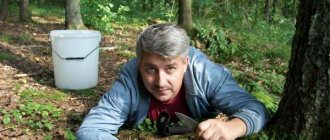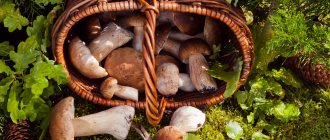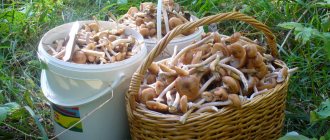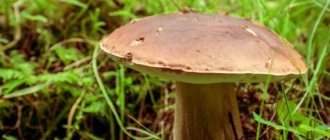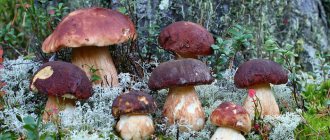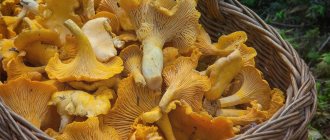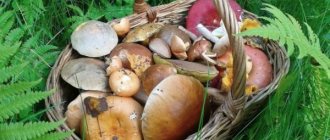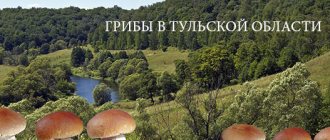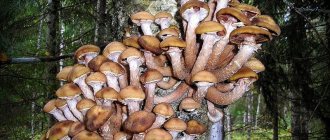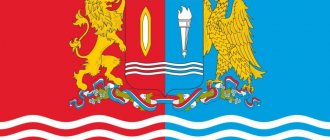9K 13 min.
On the eve of the start of the mushroom season, “Ogonyok” went for the gifts of the forest with the main Russian mushroom picker - Candidate of Biological Sciences, mycologist, author of dozens of bestsellers about mushrooms, Mikhail Vishnevsky. Mycologist debunked mushroom myths, told mushroom sensations and ate fly agarics
Red fly agaric becomes edible after several boils
Photo: Biosphoto/Mike Lane/DIOMEDIA
For mushroom hunting in the summer, Mikhail chose a sunny forest near the Pirogovskoye reservoir in the Moscow region. There should be mushrooms on the wet bank. We find the first one almost immediately. At the roots of a birch tree in the grass there is a gray mushroom with white spots. “This is a gray-pink fly agaric. Or the pinkish fly agaric,” says Mikhail. “The most delicious of our fly agarics, completely edible and not hallucinogenic.” It can be eaten raw. To understand what the subtle fly agaric taste is, try it.” The mycologist takes a large bite from the cap and chews with pleasure. I try the leg. At the site of the break, the white flesh begins to turn red. That's why it's called "pinkish". “It is sweetish, you can feel the nut, and if you fry it, it will be like chicken,” the scientist relishes, “this is one of our most delicious mushrooms, the taste is not inferior to white mushrooms. Handsome." The mushroom is really sweet and nutty.
How bumblebee farming became an advanced industry in Russia
Mikhail is short, athletic, and bearded. Looks more like a forester than a scientist. He is the main popularizer of knowledge about mushrooms in Russia. Gives lectures, leads excursions into the forest, writes books, organizes survival trips. Several years ago, having overcome the publishers’ fear and hatred of fly agarics, the mycologist published the book “His Majesty the Fly Agaric.” It turns out that among fly agarics there are many edible and even delicacy ones. For example, the most famous European delicacy is the Caesar mushroom, or Caesar's fly agaric. This is an orange fly agaric, but the leg and plates under the cap are bright yellow. Southern European gourmets adore it. Our Caesar mushroom grows in Crimea and the Krasnodar region. “Our Russian horror of fly agarics is greatly exaggerated,” says the mycologist. Americans are a very mushroom-phobic nation. But in the reference books the red fly agaric is listed as edible after boiling twice. In our country it is considered poisonous. In fact, the lethal dose for an adult is 12 kilograms. It is basically impossible to eat such a quantity of fly agarics. Table salt has a lethal dose of 5 kilograms, Mikhail clarifies. In the entire history of observing the red fly agaric, the only fatal case, he says, occurred in 1984 in Philadelphia. A four-year-old girl ran into the forest and lived there for two days, eating almost exclusively fly agarics. She could not be saved. This is how the myth about the deadly poisonousness of the red fly agaric appeared, which has especially taken hold among us.
Improving your health during the mushroom season - useful and practical
The air in the forest in autumn is fresh and transparent. Rich in biologically active (more than 200 types) volatile substances that charge our body and increase mental and physical activity.
Walking helps prevent cardiovascular diseases, as well as the musculoskeletal system. This is good ventilation and exercise for our lungs. Metabolism accelerates and excess calories are burned.
The forest has a beneficial effect on the emotional and psychological state of a person, since the green color, which predominates in the forest, has a calming effect. The nervous system returns to normal. The functioning of the cardiovascular system is stabilized, and this helps lower blood pressure.
Fresh forest air and physical activity while walking dilates blood vessels and relieves eye fatigue. Birds singing relieves depression. The absence of city noise and the silence of the forest restore a person’s hearing abilities.
The snow was cleared and broken
Russia is very rich in mushrooms, but the amateur mushroom picker is familiar with only a very small part of this wealth. We, says Mikhail, have about 800 species of edible mushrooms. According to the most conservative estimates, 5 million tons of edible mushrooms grow in our forests every year. And most of them are in Siberia. We use only 10 percent of this forest reserve. The average Russian eats 10 kilograms of mushrooms per year. Advanced city dwellers go into the autumn forests and collect 30–50 types of mushrooms. Village ones are even smaller - 10–15 species. This is because they prefer certain seasonal mushrooms. For a city dweller, picking mushrooms is a means of meditation, the quiet joy of being in the forest and filling a basket with stems and caps. A village mushroom picker purposefully creates winter supplies.
The shore of the reservoir is dotted with modest grayish caps of pinkish fly agaric. In search of other mushrooms, we decisively go deeper into the forest. It’s hard to believe in the success of the trip. Seriously, what kind of mushrooms can there be in June?
“Mushrooms can be collected almost all year round,” says the scientist. “If there was a rainy autumn, a snowy winter and the snow melted at the beginning of April, then you can start collecting mushrooms in late April - early May. Morels and lines appear. Then there is a short conditional break until the beginning of June. Then mushrooms appear, which are called spikelets, because at this time the rye begins to spike. These are boletus, boletus, boletus. The first porcini mushrooms are also found. The spikelets grow until August. It is clear that mushroom abundance comes in autumn. There are mushrooms that can be collected in winter. Oyster mushroom grows all winter. Frost-resistant classic - winter honey fungus. It has natural antifreezes - special frost-resistant proteins. If oyster mushroom can withstand temperatures down to minus 5–10, then winter honey fungus is resistant to any minus. The snow was cleared and broken... People have many false beliefs about mushrooms, and facts like the existence of winter mushrooms amaze them.”
For Russians, mushrooms are a strange object of love and fear. Many myths have developed around them.
Every lover has tried the almost ritual soaking of onions and garlic with mushrooms. If the onion turns blue, it means the mushroom is poisonous. In America, in order to distinguish an edible mushroom from an inedible one, a handful of rice is thrown into water with mushrooms. The rice has turned red - the mushroom is poisonous, throw it away. “These everyday methods of determining the edibility of a mushroom are not scientific. And the described chemical reaction is caused by certain amino acids, which are found equally in both edible and poisonous mushrooms,” explains Mikhail, “there are a countless number of philistine myths around mushrooms. Well, for example, it is believed that bad mushrooms taste and smell disgusting, but good ones are pleasant. Those who have tried the pale toadstool and survived speak with great respect of its taste. Another prejudice: if a mushroom is wormy, it means it is edible. This is wrong. Worms happily eat both the poisonous toadstool and the very poisonous, smelly fly agaric. Moreover, these same mushrooms, which are dangerous to humans, are eaten by animals - mice and foxes, but they don’t care. There is also an opinion that if you boil mushrooms for more than two hours, then after that you can eat them, no matter how poisonous they were initially. And this is not true! The longest experiment on boiling toadstool lasted two and a half years, and its poison did not go away. A large amount of salt and vinegar does not help cope with the poison in mushrooms.”
How to pick mushrooms: cut or twist? There are also a lot of prejudices and ideological opponents here. “Answer: it doesn’t matter! - says Mikhail Vishnevsky. - At least tear it out. This does not harm the mycelium. It is absolutely clear where the belief that mushrooms cannot be cut came from. It started in 1923. Hereditary botanist Regel wrote a brochure on champignon growing. And there he emphasized that the mushrooms need to be twisted. Yes, this is true for champignons. But for all other mushrooms there is no.”
Until the 20th century, by the way, there was no question of cutting or unscrewing at all. Imagine a peasant entering the forest with a knife. It's almost a riot.
What can await a person in the forest during mushroom season?
With all these positive aspects, the forest is fraught with many dangers. Such as ticks, poisonous snakes and the collection of poisonous mushrooms, which can later be poisoned. But, as they say, if you are afraid of wolves, don’t go into the forest.
Turtlenecks, long sleeves and hats are worn against ticks. In tourism goods stores you can also find special clothing with tick traps. Rubber boots are worn against snakes. And to collect the right mushrooms, there are various reference books, and the collected mushrooms must be shown to an experienced mushroom picker.
You should also take a compass with you into the forest, modern navigation aids that are often built into mobile phones. However, they will never replace a compass that will not run out of charge at the most inopportune moment. Take a couple of sandwiches, drinking water, a knife, a basket.
First there was a mushroom
Mikhail Vishnevsky demonstrates: many mushrooms can be eaten even raw
Photo: Kristina Kormilitsyna, Kommersant
For all our passion for mushrooms, they are not really food for humans. The cell walls of fungi are made of chitin, like the shells of insects or crayfish. And we don’t have enzymes that could digest it. What we chew lightly is assimilated. The only way to get the nutrient from a mushroom is to grind it as much as possible to break the cell walls. Mushroom caviar is ideal in this sense. Or dried mushroom powder. This is the form in which mushrooms are consumed in Asia. They believe that mushrooms are an easy, dietary, nutritious product that can help you lose weight.
“Mushrooms contain everything that is found in animal products, with the exception of vitamin B12,” says Mikhail. “Mushrooms are an independent kingdom of life, which, meanwhile, is related to the animal kingdom. They are our relatives. A special shout out to vegetarians here. In principle, it is believed that fungi and animals diverged somewhere between 3 and 3.5 billion years ago. Then there was a common ancestor. There is some possibility that mushrooms were our ancestor. And at some point—precisely 3–3.5 billion years ago—animals, like a mobile branch, split off from the fungi.”
So it turns out that Kuryokhin’s “Lenin-mushroom” program may not be so far from the truth! There is only a grain of joke in it. The theory that first there was a mushroom is put forward by serious groups of scientists from England and the USA. She is supported by Alexander Markov, our leading evolutionist, head of the Department of Biological Evolution at Moscow State University. The fact that mushrooms and animals either had a common ancestor, or one of them descended from the other, is already a proven fact. The only question is the sequence of events.
...The forest is dry, hot and dazzlingly sunny. Pinkish fly agaric mushrooms are replaced by large greenish russula. Mikhail points to a red, wavy growth on a rotten stump. “This is a sulfur-yellow tinder fungus,” he explains. “The Americans call it chicken of the woods. It is bright orange, very soft, and can be sliced like steak in thick layers. Tastes similar to chicken. It is prepared with cream and shallots, it turns out very tasty. Here it grows from mid to late May on oak and linden trees.”
And yet, despite the fact that the sulfur-yellow tinder fungus is still outside the sphere of our gastronomic interest, no other nation can compare with our love for collecting mushrooms. But in terms of the abundance of mushrooms, Russia is only in second place. The first one is the USA. They have more mushrooms, and the species diversity is higher, but they collect mushrooms, of course, not with the same fanaticism as we do. The passion for mushrooms in Russia began not so long ago - 200-300 years ago, it was then that people flocked to the forest to pick mushrooms. And in many ways this “mushroom fever” is connected with our posts. 200 days of fasting forced our ancestors to seek culinary variety. The depleted supply of fish by the 17th–18th centuries and its rise in price led to the fact that mushrooms became the main food during fasting. First, three types of mushrooms were collected - porcini, milk mushrooms and saffron milk caps. Then we gradually got closer to the autumn honey mushrooms, boletus, boletus, and chanterelles.
Another reason that the Slavs (Russia, Czech Republic, Poland, Bulgaria) collect mushrooms, and France, England, and Germany consider this hobby strange, lies in completely different mythologies. “In France, England, and Germany, mushrooms were considered characters of the chthonic world along with snakes, witches, leeches, and devils,” explains Mikhail Vishnevsky, “for them mushrooms are a symbol of evil magic. In addition, now in many countries in Europe, for example in Germany, Switzerland, it is simply impossible to collect mushrooms in the forest. For this there is a fine of 200 euros. This is how they protect their nature.” In Russia, since the mid-19th century, a mushroom picker or mushroom picker (as mushroom pickers were then called) paid a tax of 30 kopecks per year and could collect mushrooms in any quantity. In some years, the amount of this duty collected by the state reached a total of half a million rubles. That is, every 10th person collected, prepared and handed over mushrooms. There was a system of mushroom farms. Merchants from Moscow and St. Petersburg came to the forests in the Kostroma and Yaroslavl provinces. They set up cauldrons right at the exit from the forest and accepted mushrooms from the pickers. Now this system, which existed for 150 years, has collapsed. After perestroika, separate mushroom factories operated, but now they no longer exist. There is no mushroom picking industry in our country.
Where to look for mushrooms in Kuban
Mushrooms also grow in Kuban. It turns out that there are more than 600 species in the Krasnodar region. And only 40 of them are edible. Can you imagine? In the Moscow region there are 10 times fewer of them. That is, it turns out that almost all species gathered in Kuban :-). I doubted...
The Tuapse, Apsheronsky, Sochi districts are recognized as the most mushroom in the region, where it is humid, the villages of Dakhovskaya, Smolenskaya, Kaluzhskaya, Goryachiy Klyuch, they say that there are a lot of whites in the Labinsky district. Most often they travel from Anapa towards the villages of Gostagaevskaya and Varenikovskaya. But history is silent about Anapa. In Supsekha there are no mushrooms.
The resort in the mushroom rating looks like a poor relative. You understand, when there are no forests, no rain, but there is heat and dryness, then what kind of mushroom will want to grow here. But we want mushrooms; years of living in Siberia and the North have given us an excitement and passion for forest production. Not to mention how delicious it is to put salty, glossy-looking russula the size of a fingernail into your mouth. Delicacy!
We didn’t look for mushrooms on the Kola Peninsula, we simply came to the forest-tundra and collected baskets full of them. Although there were crop failures and I had to search for boletuses, boletuses, russula, and trumpets, and it was always a pleasure. They prepared a lot, but during the long polar winter everything was quickly destroyed.
Having settled on the coast, we immediately checked the nearby area for the presence of mushrooms. And, of course, against the background of the northern mushroom riot, the southern ones seemed to us a complete misunderstanding. Therefore, for several years such production was neglected altogether.
This year, the beginning of September turned out to be relatively rainy, the nights were cold, and the day was not as hot as usual. Mushrooms have appeared on the market, which means it’s time.
Money from the forest
“What is sold in supermarkets - pickled salted mushrooms in jars - is almost 100 percent Chinese production,” says Mikhail. “With the exception of three domestic producers from Siberia, Yoshkar-Ola and the Vladimir region. They have their own processing plants, they accept mushrooms from the population, and their products are available in retail. But this is a drop in the ocean. Mostly in stores there are salted and pickled mushrooms in glass jars from China.”
It is clear that the milk mushrooms and honey mushrooms indicated on the labels do not grow in China. Instead, cultivated mushrooms, primarily shiitake, are placed in jars. They are called milk mushrooms. And the scales on the label are called honey mushrooms, saffron milk caps and chanterelles because they are orange in color. “The price decides everything,” mycologist Vishnevsky notes sadly. “It may taste like vinegar, but a jar costs a hundred rubles. Our jars of saffron milk caps, milk mushrooms, white mushrooms, and chanterelles cost from 250 rubles for the smallest volume. Here we and the Chinese cannot withstand competition.”
Now the Russian mushroom business looks like this: in each region there are from one to three players who organize teams of villagers, and they bring them mushrooms.
They take them from the collectors and bring them to another village, where they know how to prepare them - for some reason, the ability to collect well and prepare them do not coincide. And already pickled, salted, dried mushrooms are taken and sold to restaurants or cafes, or it is rented to the three large mentioned manufacturers. But the vast majority of the collection is sent abroad. Everything that is collected in Siberia is bought by the Chinese. Chanterelles, morels and whites from the European part are sent to Europe. And never under the guise of Russian mushrooms. Poland, Lithuania and Belarus buy them, call them their own and resell them to Europe. This is a huge business for them. Our mushroom exports are 90 percent black. The volume of this market is about 200 million dollars. “I was invited to the Ministry of Agriculture,” Mikhail laughs. “At the beginning of winter, they created a working group on wild plants. This includes everything that is not cultivated - mushrooms, nuts, berries - an unplanned part of the harvest. They began to think about how they could make money from this. I went there, naive, and began to tell him: guys, now we will bring back the Russian Consumer Cooperation, our villages will go out into the forests, jobs will appear, we will not have Chinese mushrooms sold in stores, but Russian ones. They listened and said: stop! We are not interested in rubles! We are only interested in dollars. Tell us how to create new export local brands, new types of eco-bioproducts that will go to the East and West, and we will be interested in this if the export volume is at least 700 million dollars a year. And this, of course, is impossible. For mushrooms, 7–8 million is the real ceiling. But for the state it’s a pittance; it doesn’t need it.”
But Russia is relying on cultivated mushrooms. Currently, more than ten giant agricultural complexes for the cultivation of champignons and oyster mushrooms are being established throughout the European part of Russia. Agricultural complexes were built in the Yaroslavl region, near Kursk, Samara, Voronezh, and Ryazan. Champignons are a quick, direct profit - a harvest every 2-3 months. One square meter of land produces 10–15 kg of cucumbers or 5 kg of potatoes, generally 1.5–2 kg of grain, and 1 square meter of compost can produce up to 250 kg of mushrooms. Here's the scale! All this business is state-owned or the state acts as a co-investor. It is impossible to export future tons of champignons. Our champignons are of worse quality than European ones. “The volume of production that is being planned now is obviously higher than the consumer capacity of the population,” states the mycologist. “This means that for a few more years, both in 20 and 21, we will all be eating champignons and oyster mushrooms. They will be supplied to schools and government agencies. Otherwise, how can we process this amount?”
But here, Mikhail sighs, there is a problem. It turns out that we don’t have our own compost to grow champignons. To grow them, you need manure - so far all our champignon farms buy it in Poland or Ukraine. “Those who build these agricultural complexes will have to solve this problem,” says Mikhail, “or continue to purchase manure from unfriendly Ukraine. Ukrainians know how to recycle their own, I’m sorry, crap, but we don’t.”
The mushroom market itself is at a crossroads in the country. Yes, there are a certain number of people for whom picking mushrooms in the forest is a tradition, and for them the best mushroom is a forest mushroom, with spruce needles stuck to the cap, smelling of earth. But the younger generation no longer understands how they can go into the wild forest and collect something from the ground. Their mushroom ideal is a package of sterile champignons. Nowadays there is a balance between lovers of the wild and the sterile. And it all depends on how to give social advertising and what to focus on. Wherever the demand goes, that’s where it will go.
Mushroom time 2022
It rained a couple of days ago, slightly soaking the ground, but this is not enough for the forest. NO mushrooms!!!! We will wait for more rain and fog).
After the heavy rain on Friday, the first mushrooms have already appeared: russula. boletus. But all from the words of people who returned from the forest today. We haven’t been there yet, the soil needs to be well saturated, then mushrooms will grow from it. We are waiting... and maybe tomorrow my husband will run to investigate.
My husband went to the Supsekh area, but alas... he didn’t really find anything. Still, the rain was insignificant, and the restored heat does not promote the growth of mushrooms.
Write in the comments, maybe you found something if you were in the forest.
Share with friends:
Voodoo mushrooms
Mushrooms have been seriously studied and described since the 18th century
Photo: Wellcome Images CC/DIOMEDIA
We walk into a fenced-in area of forest near the water. Along the shore, near the rotten piers, there are old barges. There are black shapeless growths on birch trees.
“This is chaga,” says Mikhail Vishnevsky, picking at the growth, “one of the most useful medicinal mushrooms. It grows only here and in Finland. Chaga is very popular now all over the world. It is called Russian superfood. Chaga is now our number one exported mushroom. The raw materials come from us - and the whole world makes dietary supplements, sports nutrition, and chaga teas from it. Chagachino is popular - it comes from the word “cappuccino”. Several chains have opened that sell chaga teas and chagachino in America and Europe. Chaga is very useful for ulcers and gastritis. Many people try to use it to treat cancer - this is a big misconception. But in the terminal stages, chaga gives a powerful analgesic effect, better than medicine.” Red fly agaric is also one of the most useful among medicinal mushrooms. It helps with many diseases. From obesity and baldness to joint diseases and skin cancer. In Israel it is used to treat joint diseases; in Germany it is used for pulmonary diseases, including tuberculosis. In Europe, drugs are made from it. In general, a large number of different products can be produced from mushrooms. In Europe and America they make mushroom beer and mushroom vodka. Beer made from oyster mushrooms, shiitake, and saffron milk caps is gaining popularity. Several producers sell truffle vodka. Even jam is made from mushrooms - from yellow and black chanterelles. “A lot of sports nutrition is made from mushrooms,” continues Mikhail. “There is another powerful mushroom - cordyceps. It parasitizes insects. Turns them into zombies. The fungal spore hits the ant and causes it to change behavior. At first, he eats a lot and takes food from his relatives. Then he climbs high up a tree, tightly clings his jaws to a leaf, and gradually a cordyceps mushroom grows from his head. It is from above the tree that it is most convenient for him to disperse spores to the anthill, which is located below. So cordyceps is a powerful adaptogen. Prepares the body for any potential diseases, including viral ones. If you eat cordyceps, it is almost impossible to get sick. 10 grams per year is enough. The Chinese Olympic team took almost all the gold medals in 2008. So she is officially on cordyceps. It is used to make powerful sports nutrition and energy drinks. Meldonium is much more effective.”
Behavior control is a common phenomenon in the natural world. Research is currently being conducted on this topic. It is amazing that the fungus forces the ant to hover over the anthill in order to scatter spores onto it and zombify other ants. And it turns out that the ant is controlled by very simple chemistry, which involves two or three fairly simple substances. “A mushroom is no wiser than an ant, it’s just much older,” says Mikhail. “And if you have hundreds of millions of years to hone this art of manipulation and do it sequentially in several stages... Mushrooms in the modern sense began to evolve from 800 million to a billion years ago . About 200 million years ago, all the mushrooms that grow now already existed. All mushroom poisons and hallucinogenic effects of mushrooms are not intended for us - man was not yet in their way. Man for mushrooms is an extremely young object. Well, how old are people? A maximum of 2 million. Mushrooms are just getting used to us. We humans are too young for mushrooms to notice us. We just started eating food that wasn’t ours—mushrooms. Our body has not gotten used to them for thousands of years. We are stalkers in the zone. And little by little we are exploring this area. The Northern Hemisphere has been explored very well, the Southern Hemisphere is so-so and the islands are poorly studied. Thousands of new fungal species are described every year. And what will happen when the mushrooms notice us is a very interesting question.”
In the evening for dinner I had pinkish fly agarics fried with onions, which tasted like chicken, nuts and ginger. But the subtle fly agaric taste, of course, cannot be described. You just need to try it.
Natalia Nekhlebova
